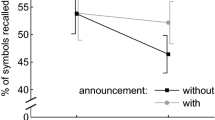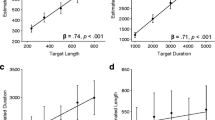Abstract
In the present study, we used single- and dual-task conditions to investigate the nature of topographical working memory to better understand what type of task can hamper performance during navigation. During dual-task conditions, we considered four different sources of interference: motor (M), spatial motor (SM), verbal (i.e. articulatory suppression AS) and spatial environmental (SE). In order to assess the nature of topographical working memory, we used the Walking Corsi Test, asking the participants to perform two tasks simultaneously (M, SM, AS and SE). Our results showed that only spatial-environmental interference hampers the execution of a topographical working memory task, suggesting a task-domain-specific effect. We also found general gender differences in the topographical working memory capabilities: men were more proficient than women, regardless of the type of interferences. However, like men, women performed worse when a spatial-environmental interference was present.

Similar content being viewed by others
References
Avraamides M, Loomis JM, Klatzky RL, Golledge RG (2004) Functional equivalence of spatial representations derived from vision and language: evidence from allocentric judgments. J Exp Psychol Learn Mem Cogn 30:801–814
Baddeley AD (1986) Working memory. Clarendon Press, Oxford
Bianchini F, Incoccia C, Palermo L, Piccardi L, Zompanti L, Sabatini U, Peran P, Guariglia C (2010) Developmental topographical disorientation in a healthy subject. Neuropsychologia 48:1563–1573
Bianchini F, Palermo L, Piccardi L, Incoccia C, Nemmi F, Sabatini U, Guariglia C (2014) Where am I? A new case of developmental topographical disorientation. J Neuropsychol 8:107–124
Boccia M, Piccardi L, Palermo L, Nemmi F, Sulpizio V, Galati G, Guariglia C (2014a) A penny for your thoughts! patterns of fMRI activity reveal the content and the spatial topography of visual mental images. Hum Brain Mapp. doi:10.1002/hbm.22678
Boccia M, Piccardi L, Palermo L, Nemmi F, Sulpizio V, Galati G, Guariglia C (2014b) One’s own country and familiar places in the mind’s eye: different topological representations for navigational and non-navigational contents. Neurosci Lett 579:52–57
Boccia M, Nemmi F, Guariglia C (2014c) Neuropsychology of environmental navigation in humans: review and meta-analysis of FMRI studies in healthy participants. Neuropsychol Rev 24:236–251
Cocchini G, Logie RH, Della Sala S, MacPherson SE, Baddeley AD (2002) Concurrent performance of two memory tasks: evidence for domain-specific working memory systems. Mem Cogn 30:1086–1095
Coluccia E, Iosue G (2004) Gender differences in spatial orientation: a review. J Environ Psychol 24:329–340
Corsi PM (1972) Human memory and the medial temporal region of the brain. Diss Abstr Int 34(02):891B. doi:10.2466/01.13.17.PR0.109.4.309-326 (University micro-lms No. AA105-77717)
Epstein RA (2008) Parahippocampal and retrosplenial contributions to human spatial navigation. Trends Cogn Sci 12:388–396
Epstein RA, Parker WE, Feiler AM (2007) Where am I now? Distinct roles for parahippocampal and retrosplenial cortices in place recognition. J Neurosci 27:6141–6149
Friedman NP, Miyake A (2000) Differential roles for visuospatial and verbal working memory in situation model construction. J Exp Psychol Gen 129:61–83
Grön G, Wunderlich AP, Spitzer M, Tomczak R, Riepe MW (2000) Brain activation during human navigation: gender-different neural networks as substrate of performance. Nat Neurosci 3:404–408
Hermer-Vasquez L, Spelke ES, Katsnelson AS (1999) Sources of flexibility in human cognition: dual-task studies of space and anguage. Cogn Psychol 39:3–36
Hupbach A, Hardt O, Nadel L, Bohbot V (2007) Spatial reorientation: effects of verbal and spatial shadowing. Spat Cogn Comput 7:213–226
Iaria G, Barton JJ (2010) Developmental topographical disorientation: a newly discovered cognitive disorder. Exp Brain Res 206:189–196
Iaria G, Chen J, Guariglia C, Ptito A, Petrides M (2007) Retrosplenial and hippocampal brain regions in human navigation: complementary functional contributions to the formation and use of cognitive maps. Eur J Neurosci 25:890–899
Kozlowski LT, Bryant KJ (1977) Sense of direction, spatial orientation, and cognitive maps. J Exp Psychol Learn Mem Cogn 3:590–598
Logie RH (1995) Visuo-spatial working memory. Lawrence Erlbaum, Hillsdale
Logie RH (2003) Spatial and visual working memory: a mental workspace. In: Irwin DE, Ross BH (eds) The psychology of learning and motivation. Advances in research and theory: cognitive vision. Academic, London, pp 37–78
McNamara TP, Rump B, Werner S (2003) Egocentric and geocentric frames of reference in memory of large-scale space. Psychon Bull Rev 10:589–595
Nemmi F, Boccia M, Piccardi L, Galati G, Guariglia C (2013) Segregation of neural circuits involved in spatial learning in reaching and navigational space. Neuropsychologia 51:1561–1570
Nemmi F, Bianchini F, Piras F, Peran P, Palermo L, Piccardi L, Sabatini U, Guariglia C (2014) Finding my own way: an fMRI single case study of a subject with developmental topographical disorientation. Neurocase. doi:10.1080/13554794.2014.960424
Nori R, Piccardi L (2011) Familiarity and spatial cognitive style: how important are they for spatial representation? In: Thomas JB (ed) Spatial memory: visuospatial processes, cognitive performance and developmental effects. Nova Publisher, New York, pp 123–144
Nori R, Grandicelli S, Giusberti F (2009) Individual differences in visuo-spatial working memory and real-world wayfinding. Swiss J Psychol 68:7–16
Nori R, Piccardi L, Migliori M, Guidazzoli A, Frasca F, De Luca D, Giusberti F (2015) The virtual reality Walking Corsi Test. Comput Hum Behav 48:72–77
Palermo L, Piccardi L, Bianchini F, Nemmi F, Giorgio V, Incoccia C, Sabatini U, Guariglia C (2014) Looking for the compass in a case of developmental topographical disorientation: a behavioural and neuroimaging study. J Clin Exp Neuropsychol 36:464–481
Piccardi L (2009) Representational neglect and navigation in virtual space. Cogn Neuropsychol 26:S266–S267
Piccardi L, Iaria G, Ricci M, Bianchini F, Zompanti L, Guariglia C (2008) Walking in the Corsti Test: which type of memory do you need? Neurosci Lett 432:127–131
Piccardi L, Berthoz A, Baulac M, Denos M, Dupont S, Samson S, Guariglia C (2010) Different spatial memory systems are involved in small- and large-scale environments: evidence from patients with temporal lobe epilepsy. Exp Brain Res 206:171–177
Piccardi L, Iaria G, Bianchini F, Zompanti L, Guariglia C (2011) Dissociated deficits of visuo-spatial memory in near space and navigational space: evidence from brain-damaged patients and healthy older participants. Neuropsychol Dev Cogn B Aging Neuropsychol Cogn 18:362–384
Piccardi L, Bianchini F, Argento O, De Nigris A, Maialetti A, Palermo L, Guariglia C (2013) The Walking Corsi Test (WalCT): standardization of the topographical memory test in an Italian population. Neurol Sci 34:971–978
Piccardi L, Bianchini F, Nori R, Marano A, Iachini F, Lasala L, Guariglia C (2014a) Spatial location and pathway memory compared in the reaching vs. walking domains. Neurosci Lett 566:226–230
Piccardi L, Palermo L, Leonzi M, Risetti M, Zompanti L, D’Amico S, Guariglia C (2014b) The Walking Corsi Test (WalCT): a normative study of topographical working memory in a sample of 4- to 11-year-olds. Clin Neuropsychol 28:84–96
Piccardi L, Palermo L, Bocchi A, Guariglia C, D’Amico S (2015) Does spatial locative comprehension predict landmark-based navigation? PLoS One 10(1):e0115432. doi:10.1371/journal.pone.0115432
Ratliff KR, Newcombe NS (2008) Is language necessary for human spatial reorientation? Reconsidering evidence from dual task paradigms. Cogn Psychol 56:142–163
Rizzolatti G, Berti A, Gallese V (2000) Spatial neglect: neurophysiological bases, cortical circuits and theories. In: Boller F, Grafman J, Rizzolatti G (eds) Handbook of neuropsychology. Elsevier, Amsterdam, pp 503–537
Sandstrom NJ, Kaufman J, Huettel SA (1998) Males and females use different distal cues in a virtual environment navigation task. Brain Res Cogn 6:351–360
Shusterman A, Lee SA, Spelke ES (2011) Cognitive effects of language on human navigation. Cognition 120:186–201
Verde P, Piccardi L, Bianchini F, Guariglia C, Carrozzo P, Morgagni F, Boccia M, Di Fiore G, Tomao E (2015) Gender differences in navigational memory: pilots vs. nonpilots. Aerosp Med Hum Perform 86:103–111
Wen W, Ishikawa T, Sato T (2011) Working memory in spatial knowledge acquisition: differences in encoding processes and sense of direction. Appl Cogn Psychol 25:654–662
Wen W, Ishikawa T, Sato T (2013) Individual differences in the encoding processes of egocentric and allocentric survey knowledge. Cogn Sci 37:176–192
Wolbers T, Hegarty M (2010) What determines our navigational abilities? Trends Cogn Sci 14:138–146
Author information
Authors and Affiliations
Corresponding author
Rights and permissions
About this article
Cite this article
Piccardi, L., Nori, R., Boccia, M. et al. A dedicated system for topographical working memory: evidence from domain-specific interference tests. Exp Brain Res 233, 2489–2495 (2015). https://doi.org/10.1007/s00221-015-4320-y
Received:
Accepted:
Published:
Issue Date:
DOI: https://doi.org/10.1007/s00221-015-4320-y




